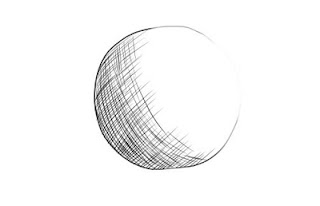The basics staff will be chiefly for those young kids who wants to take up drawing as a hobby or wish they could draw like a pro and are yet to set foot on the track of learning. Today we will be discussing the very basics of drawing that are fundamental and building blocks to a finished drawing.
The line
When you sit to draw something with a pencil and a paper(the most popular drawing kit for a beginner), the first marks are always in the shape of a line. The novice eye tends to see and define everything by some lines. A children would probably draw a human eye something like the one below:
When you sit to draw something with a pencil and a paper(the most popular drawing kit for a beginner), the first marks are always in the shape of a line. The novice eye tends to see and define everything by some lines. A children would probably draw a human eye something like the one below:
Though the drawing lacks in so many aspects of a good drawing and also affected by inexperience observation, one thing is affirmed that, line is the very basic building block to construct a figure. In its primary use, it gives outline to a shape and its major parts such as in the following drawing.
Line also serves to separate two highly contrasting area while starting to build and distinguish separate value/tonal areas. In the following drawing we can see that the lines on the shirt is to suggest creases in the shirt. Creases are areas of depression where much light cant reach and therefore darker than nearby areas giving a high contrast which can be depicted as line.
Hatching
Lines when used in hatching suggests tonal value. Tone is the extent of lightness of darkness in an area of drawing. While hatching with closely placed lines may suggest darker tone, parallel hatching with spaced lines will suggest lighter tones.Cross hatching also suggests darker tone. The image below demonstrates this.
Lines when used in hatching suggests tonal value. Tone is the extent of lightness of darkness in an area of drawing. While hatching with closely placed lines may suggest darker tone, parallel hatching with spaced lines will suggest lighter tones.Cross hatching also suggests darker tone. The image below demonstrates this.
There are two types of hatching that are used most frequently. They are the parallel hatching and cross hatching. Another lovely hatching style is the contour hatching(image below), which as the name suggests, tends to follow the contour of the object volume.
We talk more about the basics in our next tutorial post.





No comments:
Post a Comment